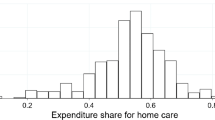Abstract
The demographic changes that have taken place throughout the twentieth and early twenty-first century confirm the increase in the number of older adults. More older adults implicitly entail an increase in the number of people in a situation of dependence. The issue of long-term care has economic, social and health care implications. This article addresses the characteristics of the companies involved in long-term care services and the employment generated. The database of the Spanish Directory of Companies (DIRCE) provided information on the variables used in the analysis: companies created, employment generated, companies by legal status and territorial distribution of the companies. Noteworthy findings were that the long-term care service sector contributes more to creating jobs than other economic sectors and that third sector companies are important in providing long-term care services.

Similar content being viewed by others
Notes
The Central Directory of Companies (Spanish acronym, DIRCE) offers in a single information system all Spanish companies and their local offices located in Spanish territory. The purpose of the directory is to allow economic surveys to be made by sampling. It is updated once a year, generating a new information system on 1 January of each period. A statistical analysis of the results for companies and local offices is published. Results are expressed in relation to autonomous community and legal situation, primary economic activity and stratum of employees assigned.
References
Ben-Ner, A., & Gui, B. (Eds.). (1993). The nonprofit sector in the mixed economy. Ann Arbor: The University of Michigan Press.
Benz, M. (2009). Entrepreneurship as a non-profit-seeking activity. International Entrepreneurship and Management Journal, 5, 23–44.
Bolin, K., Lindgren, B., & Lundborg, P. (2008). Your next of kin or your own career? Caring and working among the 50+ of Europe. Journal of Health Economics, 27(3), 718–738.
Cambridge Small Business Research Centre. (1992). The state of British enterprise: Growth, innovation and competitive advantage in small and medium sized firms. University of Cambridge: Small Business Research Centre.
Commission of the European Communities. (2006). The demographic future of Europe—From challenge to opportunity. COM (2006) 571 final.
Committee of Ministers of the Council of Europe (1998). Recomendation (98) 9 on dependence. Approved 18th September 1998.
Ebrahim, S. K. A. (1996). Epidemiology of old age. London: WHO/BMJ Books.
European Commission. (1995): Local development and employment initiatives. Luxembourg: European Commission.
European Commission. (2006). The impact of ageing on public expenditure: Projections for the EU 25 Member States on pensions, health care, long term care, education, and unemployment transfers (2004–2050). IP/06/150.
European Commission. (2009). Demography report 2008: Meeting social needs in an ageing society. Commission Staff Working Document. Directorate General for Employment, Social Affairs and Equal Oportunities.
Hakim, C. (1989). Identifying fast growth small firms. Employment Gazette (January), 29–41.
Harwood, R. H., Sayer, A. A., & Hirschfeld, M. (2004). Current and future worldwide prevalence of dependency, its relationship to total population, and dependency ratios. Bulletin of the World Health Organization, 82, 251–258.
Hassmann, H. (1987). Economic theories of nonprofit organizations. In W. W. Powell (Ed.), The nonprofit sector. A research handbook. New Haven, London: Yale University Press.
Herce, J. A., Labeaga, J. M., Sosvilla, S., & Ortega, C. (2006). El sistema nacional de dependencia, Evaluación de sus efectos sobre el empleo. Informe de síntesis, Madrid: IMSERSO.
Lilly, M. B., Laporte, A., & Coyte, P. C. (2007). Labour market work and home care’s unpaid caregivers: A systematic review of labour force participation rates, predictors of labour market withdrawal, and hours of work. Milbank Quarterly, 85(4), 641–690.
Mansell, J., Knapp, M., Beadle-Brown, J., & Beecham, J. (2007). Deinstitutionalisation and community living-outcomes and costs: Report of a European Study. Canterbury: Tizard Centre, University of Kent. http://ec.europa.eu/employment_social/index/7002_en.html.
Rogero-García, J. (2009). Distribution of formal and informal home care for people older than 64 years in Spain 2003. Revista Española de Salud Pública, 83, 393–405.
SAAD-IMSERSO, Servicio de Estadísticas de la Subdirección General Adjunta de Valoración, Calidad y Evaluación. Estadísticas del sistema para la autonomía y la atención a la dependencia. Accessed July 29, 2009 from http://www.imsersomayores.csic.es.
Shrestha, L. B. (2000). Population aging in developing countries. Health Affairs (Millwood), 19(3), 204–212.
Storey, D. (1994). Understanding the small business sector. London: Routledge.
Tan, W. L., Williams, J., & Tan, T. M. (2005). Defining the ‘social’ in ‘social entrepreneurship’: Altruism and entrepreneurship. International Entrepreneurship and Management Journal, 1, 353–365.
Tethe, B. S., & Massini, S. (1998). Employment creation in small technological, design innovators in the U.K. during the 1980s. Small Business Economics, 11, 353–370.
United Nations, Departament of Economic and Social Affairs Population Division. (2009). World population prospects: The 2008 revision, highlights. Working Paper nº ESA/P/WP/210. http://www.un.org/esa/population/publications/wpp2008/wpp2088_highlights.
World Health Organization. (2008). The global burden of desease: 2004 update. World Health Organization. Accessed June 2009, from http://www.who.int/healthinfo/global_burden_disease/2004_report_update/en/index.html.
Young, D. (1981). Entrepreneurship and the behaviour of nonprofit organizations: Elements of a theory. In M. J. White (Ed.), Nonprofit firms in a three-sector economy. Washington, DC: Urban Institute.
Author information
Authors and Affiliations
Corresponding author
Rights and permissions
About this article
Cite this article
Escribano Sotos, F., Pardo García, I. Long-term care, dependence and the third sector. Small Bus Econ 38, 321–331 (2012). https://doi.org/10.1007/s11187-010-9277-4
Accepted:
Published:
Issue Date:
DOI: https://doi.org/10.1007/s11187-010-9277-4




